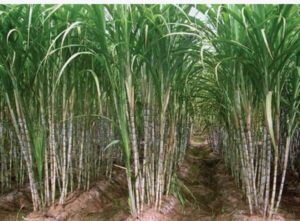Abstract
Experiment was carried out at research farm of Institute of Agricultural Sciences during spring to  assess the response of sugarcane to different spatial arrangements, earthing and nutrient doses. Treatments include S1 = planting of sugarcane in 60 cm apart furrows (conventional farmer practice) and S2 = 120 cm apart trenches (standard). Earthing up treatments include E1= No earthing, E2 = earthing at 90 DAP. Nutrient doses include F1= 100-90-90, F2=150-110-110, F3 = 200-130-130 and F4 = 250-160-160 NPK kg ha-1. More lodging was witnessed at closer furrow than wide spaced trenches. Earthing up at 90 DAP decreased the lodging. Increase in Nitrogen dose enhance the lodging %age. Highest cane yield (125 t ha-1) was given by treatment in which sugarcane was planted at wider spacing followed by earthing 90 DAP with highest dose of NPK kg/ ha. Highest sugar yield (16.85 t ha-1) was achieved in the treatment where earthing was performed 90 DAP with nutrient level of 250-160-160 NPK kg/ha.
assess the response of sugarcane to different spatial arrangements, earthing and nutrient doses. Treatments include S1 = planting of sugarcane in 60 cm apart furrows (conventional farmer practice) and S2 = 120 cm apart trenches (standard). Earthing up treatments include E1= No earthing, E2 = earthing at 90 DAP. Nutrient doses include F1= 100-90-90, F2=150-110-110, F3 = 200-130-130 and F4 = 250-160-160 NPK kg ha-1. More lodging was witnessed at closer furrow than wide spaced trenches. Earthing up at 90 DAP decreased the lodging. Increase in Nitrogen dose enhance the lodging %age. Highest cane yield (125 t ha-1) was given by treatment in which sugarcane was planted at wider spacing followed by earthing 90 DAP with highest dose of NPK kg/ ha. Highest sugar yield (16.85 t ha-1) was achieved in the treatment where earthing was performed 90 DAP with nutrient level of 250-160-160 NPK kg/ha.
Introduction
Sugarcane (Saccharum officinarum L.) is one of the important summer season crop which supports the rural economy and provide the raw material to ever increasing sugar industry of Pakistan. Sugarcane is planted on 1.21 million hectare area with sugarcane production in Pakistan of 73.6 million metric tonnes during 2016-17 with average cane yield of 60.4 t ha-1 (GOP. 2017). Pakistan is major sugarcane producing country of world in terms of area but average cane and sugar yield is less than top cane producing nations. Improper row spacing, improper and imbalance use of fertilizer and no earthing up or earthing up at improper time are some of the reasons which cause the sugarcane crop to lodge due to which cane yield and quality is badly affected (Anwar et al. 2002).The appropriate planting method is very important to completely exploit the potential of a variety (Chattha et al. 2007). Narrow spacing creates difficulty in performing different intercultural operations which are necessary for good crop growth and ultimately reduce the yield (Ehsanullah et al. 2011). Sowing of sugarcane at wider spacing improves the yield and income (Rajula Shanty and Muthusamy, 2012).Trench planting method is more easy and effective (Sarwar et al. 1996). Earthing up improves the stripped cane yield of sugarcane crop than no earthing up (Aslam et al. 2005). Lodging decreased the sugar yield up to 21% in irrigated sugarcane crop (van Heerden et al. 2015). Sugarcane quality is influenced by nutrient management (Meyer and Wood, 2001). Increase in NPK fertilizer levels improves the cane yield than control treatment (Ricaud and Arcenaux, 1987).
Considering these factors present study has been carried out to investigate the role of spatial arrangement, earthing and nutrient management on sugarcane yield under the semi-arid and sub-tropical climate.